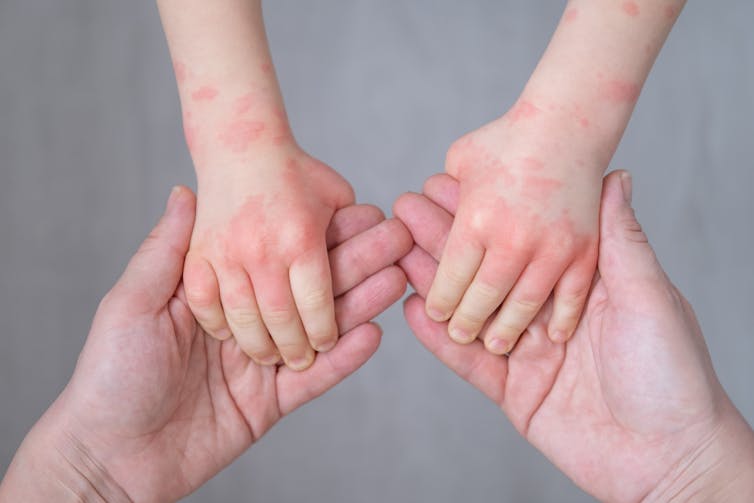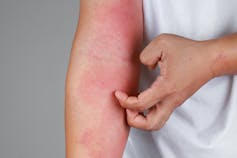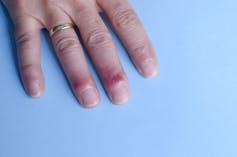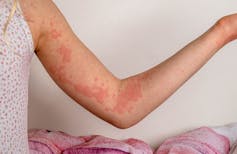
|
Getting your Trinity Audio player ready...
|
Cold weather brings itchy, irritated, dry and scaly skin – here’s how to treat eczema and other skin conditions and when to see a doctor

Yuliya Shevtsova/EyeEm via Getty Images
Sonal Choudhary, University of Pittsburgh Health Sciences and Jeffrey Chen, University of Pittsburgh Health Sciences
In many parts of the U.S., the winter months bring frigid temperatures and drier conditions that can wreak havoc on the skin.
The primary role of the skin, as the largest organ in the body, is to act as a physical barrier to the external environment. When your skin is healthy, it helps protect you from allergens and infections. But in winter, when the outside temperature and humidity drop, skin can become especially irritated.
We are a dermatologist and a medical student who study a broad range of common skin conditions and the effects of the environment on skin health.
Heading into the winter months, a handful of common dermatological conditions can develop or worsen in response to the cold. These include eczema, chilblains, Raynaud’s phenomenon, cold urticaria and cold panniculitis. All are conditions that can be irritating and uncomfortable, and some are harder to treat than others. So it’s helpful to know when to manage these conditions on your own and when to see a dermatologist.
Eczema
Eczema is an inflammatory skin condition that causes dry and itchy skin and may be triggered by soaps and detergents, environmental or food allergens, hormonal changes and skin infections. There are numerous types of eczema, which often have overlapping symptoms.

tylim/iStock via Getty Images Plus
Asteatotic eczema, also known as winter itch, is common in older adults. During the winter months, skin can become drier and, in some instances, cracked, fissured and inflamed.
Severe dryness may lead to itchiness and scratching. In turn, this can create open wounds that may allow allergens and bacteria to penetrate the skin and cause a rash or an infection.
This type of eczema typically occurs on the lower legs, but eruptions can occur anywhere on the skin, such as the trunk, arms and hands.
Keeping the skin hydrated is the primary treatment. Water-based lotions may worsen skin drying, so applying moisturizers with a high oil content – like petroleum jelly, mineral oil or Vaseline – on wet or damp skin is recommended. Hypoallergenic and anti-itch moisturizers designed specifically for eczema are also available.
Other tips include replacing long hot baths with quick warm showers, switching to a milder soap, and using a room humidifier if the climate is dry. If itchiness and dryness persist, seek care from a dermatologist, who may prescribe a topical steroid.
Hand eczema may also worsen in the winter as your hands are frequently exposed to cold, dry air. Scaling, fissuring and bleeding on the hands is common. Minimizing exposure to hard or antibacterial soaps, along with using gentle cleansing products followed by applying a petroleum-based unscented moisturizer can improve symptoms.
Chilblains
Chilblains, also known as pernio, are small, itchy patches that can occur when the skin is exposed to cold and damp weather, resulting in swollen and painful bumps that affect the fingers, toes, ears and face. Poor circulation, blood vessel constriction, a history of autoimmune disease and being underweight may predispose people to chilblains.

Elizabeth Fernandez/Moment via Getty Images
Afflicted areas are painful, itchy, swollen and usually have a blueish to purple hue. In severe cases, blisters and ulcers may occur. But for most people, the condition tends to spontaneously resolve within one to three weeks.
Until that happens, it’s important to keep affected areas protected from the cold. If the sensitive area starts to blister, or if fevers, muscle aches and chills develop, it’s best to see a dermatologist or physician.
Pseudo-chilblains, also known as “COVID toes,” can be caused by COVID-19 infection. Chilblains associated with COVID-19 resemble the rash in chilblains – painful red to blue-colored nodules on the toes – but it is not specific to winter.
Raynaud’s phenomenon
Like chilblains, Raynaud’s phenomenon is a skin condition characterized by an significant constriction of blood vessels in the fingers and toes in response to cold exposure. The digits may turn red or blue, but they quickly flush red upon rewarming. Afflicted areas may also be numb or painful, and when severe, may develop ulcers.

Barb Elkin/iStock via Getty Images Plus
To treat Raynaud’s phenomenon, it’s necessary to avoid cold-weather exposure. Ideally patients with Raynaud’s should dress for the cold in layers. At a minimum, make sure to wear gloves and insulated footwear. Avoid tobacco, caffeine and decongestants; they may cause blood vessels to constrict more. If symptoms don’t improve quickly – Raynaud’s due to cold typically gets better after only a few minutes – see a dermatologist or your physician, as Raynaud’s phenomenon can also be a manifestation of a more serious systemic disease, including cancer, infections and/or trauma.
Cold urticaria
Cold urticaria is a skin rash believed to be triggered by an autoimmune response, which leads to the release of inflammatory molecules, including histamine.

Elk Scott/i Stock via Getty Images
Soon after the skin is exposed to sudden drops in temperature, wheals – also known as hives – may develop. These are reddish, itchy and swollen areas of skin. Such episodes can last for approximately two hours. Occasionally, other symptoms accompany the outbreak, including headache, chills, shortness of breath, abdominal pain and diarrhea.
People can test for cold urticaria using the ice cube test. This is done simply by placing an ice cube on an area of skin for five minutes; if you have cold urticaria, the skin will raise and itch within five to 15 minutes. Treatment involves avoiding cold exposure and using over-the-counter antihistamines.
For those who have experienced cold urticaria, swimming in cold water can be dangerous, as it can lead to loss of consciousness and drowning.
Cold panniculitis
Cold panniculitis – which appears as enlarged, red and painful nodules on the skin – develops 12 to 72 hours after cold exposure.
Cases of cold panniculitis have been documented in children eating Popsicles and in adults undergoing whole-body cryotherapy, which is often used as treatment for chronic inflammatory conditions such as rheumatoid arthritis, or for improving post-exercise recovery.
Cold panniculitis is more common during childhood and usually resolves on its own by avoiding cold exposure and direct contact with frozen products.
Symptoms from winter skin conditions are often self-limiting and resolve on their own with adequate protection from the cold. But if symptoms do not resolve, you should see a licensed dermatologist, as cold-induced rashes may be a sign of a more concerning underlying health condition.
If visiting your dermatologist in person proves difficult, you may consider seeing a dermatologist virtually, as many academic medical centers and private practices now offer telehealth dermatology.
Sonal Choudhary, Assistant Professor of Dermatology and Dermatopathology, University of Pittsburgh Health Sciences and Jeffrey Chen, Medical Student, University of Pittsburgh Health Sciences
This article is republished from The Conversation under a Creative Commons license. Read the original article.
Human skin stood up better to the sun before there were sunscreens and parasols – an anthropologist explains why





